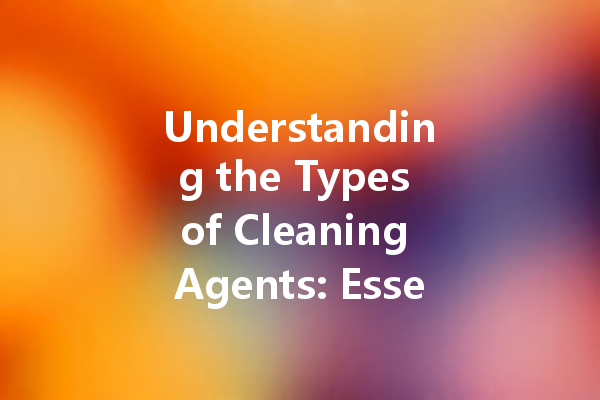Introduction
In our day-to-day lives, cleaning agents play a crucial role. From keeping our homes sparkling to ensuring our vehicles are spotless, the right cleaning agent can make all the difference. However, with so many types available, it can be confusing to know which to choose for specific tasks. This article seeks to clarify the various types of cleaning agents, their uses, and tips for effective cleaning.
What Are Cleaning Agents?
Cleaning agents are substances designed to remove dirt, stains, and unwanted contaminants from surfaces. They come in various forms such as liquids, powders, and sprays, each formulated for specific cleaning tasks. Understanding the composition and functionality of each type can enhance your cleaning processes.
Types of Cleaning Agents
All-Purpose Cleaners
All-purpose cleaners are versatile and can tackle a wide range of surfaces, from countertops to bathroom tiles. These cleaners often contain surfactants that lift dirt and grease away, making them ideal for daily use. For optimal results, apply them with a cloth or sponge, and always follow up with rinsing if necessary.
Specialty Cleaners
Some tasks require specialized cleaners made for specific materials or surfaces. For example, ceramic tile cleaners are formulated to dissolve soap scum and stains without damaging the tile’s finish. On the other hand, LCD screen cleaners are designed to clean electronics safely. Always check labels and ensure the product is suitable for the surface you intend to clean.
Disinfectants
Disinfectants are critical for areas requiring sterilization, such as kitchens and bathrooms. Unlike regular cleaners, disinfectants kill bacteria and viruses, making them essential, especially during flu season or a health crisis. When using disinfectants, follow the instructions carefully to ensure you are effectively eliminating germs.
Degreasers
Grease can be a stubborn enemy in any cleaning endeavor. Degreasers contain powerful solvents that can break down and dissolve thick grease and oil deposits, making them perfect for cleaning ovens, stovetops, and automotive engines. Apply them directly onto greasy surfaces and allow them to sit for the instructed time for maximum efficacy.
Stain Removers
Stain removers target specific types of stains, such as food, ink, or grease. Look for products that match the type of stain you are dealing with; for example, a homemade stain remover using vinegar and baking soda can be useful for fabric stains. Always test in an inconspicuous area first to avoid damage.
Understanding Cleaning Ingredients
Surfactants

Surfactants are a primary ingredient in many cleaning products. They reduce the surface tension of water, allowing it to spread and penetrate more effectively. This helps lift dirt and grime away from surfaces.
Enzymes
Certain cleaning agents contain enzymes, which are proteins that can break down stains and odors at a molecular level. Enzyme-based cleaners are particularly useful for organic stains, such as pet accidents or food spills.
Acids and Bases
Many cleaners leverage the power of acids or bases to tackle specific cleaning tasks. For example, acidic cleaners (like vinegar) can dissolve mineral deposits, while alkaline cleaners (like baking soda) are great for cutting through grease.
Tips for Effective Cleaning
Know Your Surfaces
Different surfaces react differently to cleaning agents. Always test a small, hidden area before applying a cleaner to a visible area. For example, some wood finishes might be damaged by harsh chemicals, so a gentle cleaner is usually the best choice.
Follow Instructions
Always read and follow the manufacturer’s instructions. This includes proper dilution rates, application methods, and safety precautions. Misuse can lead to ineffective cleaning or, worse, damage to the surface.
Use the Right Tools
Pairing the right cleaning tools with your cleaning agent can amplify your results. Use microfiber cloths for applying liquid cleaners, brushes for scrubbing tough stains, and sponges for wiping down surfaces.
Rinse Thoroughly
After using cleaning agents, it’s essential to rinse the surfaces thoroughly unless otherwise indicated. Residue from cleaning products can attract dirt and lead to a less clean and more dull appearance.
Conclusion
Understanding the various types of cleaning agents and their proper applications can significantly enhance your cleaning routine. Whether you’re tackling stains, disinfecting surfaces, or simply tidying up, the right cleaning agent and technique will ensure a more effective clean. Remember to always prioritize safety and effectiveness by selecting the appropriate product for your specific cleaning needs. With these tips, you’ll be well on your way to achieving a spotless environment!
